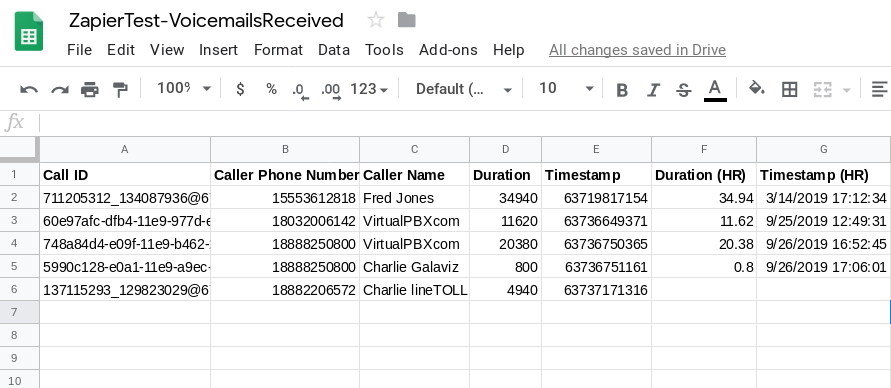 Do you need a better way to track the dozens of voicemails left for your business every day? We’ll show you how to automate the process of logging all your voicemails so you can track and reply to them easily.
Do you need a better way to track the dozens of voicemails left for your business every day? We’ll show you how to automate the process of logging all your voicemails so you can track and reply to them easily.
This quick tutorial will show you how Zapier works alongside our Business Phone Plans by providing you with a useful example: linking the VirtualPBX Zapier App with Google Sheets.
With only a few minutes of setup, you can log every message that’s left on your company voicemail boxes. Then you can take action on them, for instance, by marking them as answered or creating reports to view trends about voicemails left during certain times of year.
Zapier uses an Action-Reaction format. In this Zap:
- Action: Your VirtualPBX account receives a voicemail
- Reaction: Zapier prints that voicemail’s data into a Google Sheet
You can follow along in this tutorial by starting from the top or moving to the individual sections below:
- Common Use Cases
- Preparation of Materials
- Start a Zap (Configure VirtualPBX)
- Choose Zap Output (Configure Google Sheets)
Common Use Cases
Easily View the Count of Messages Left After Hours
See if Repeat Callers Are Missing Your Team
Show Sales the Frequency of Messages Left
Find Most Popular Voicemail Boxes
Preparation
You will need to create a Google Sheet that’s labeled to accept voicemail data like Call ID and Timestamp. The quickest way to do this is by copying our Google Sheet template.
Open the file linked above. Then click File in the menu at the top of your screen. Click Make a copy in the following drop-down menu to save the Sheet to your own Google Drive.
Action
On your Zapier home screen, you will first need to select the Make a Zap button to create a new project.

A new screen will load. This is where you begin working through the steps of your Zap. As your first step, you can select the VirtualPBX Zapier integration.

Make sure you select the VirtualPBX 1.0.6 integration version. The Choose App & Event section of this step can always be changed.

Your Trigger Event in this Zap will be the New Voicemail option. This selection will tell your Zap to trigger a reaction when a caller leaves a voicemail on your account.

Then enter your VirtualPBX Account credentials and hit Continue to proceed to the next step (adding your Google Sheet).

Reaction
As your second step – your Reaction – click the plus sign on your screen and choose your App (Google Sheets) and Action Event (Lookup Spreadsheet Row).
Your selection of Lookup Spreadsheet Row here will allow you to search for existing data and complete new lines if that data isn’t found. Here, you will search for an existing call by its unique ID. If that call isn’t listed in your spreadsheet log, Zapier will output the new call’s data in your Sheet.

Just as you did with the VirtualPBX integration, you will need to select your Google Sheets account before you can access an individual spreadsheet.

Next, select your Spreadsheet and Worksheet (the individual tab inside the chosen spreadsheet) you want to use.

The Lookup Value you select should be the Call ID option. In the drop-down menu for this selection, Zapier will list the VirtualPBX app and all the data options available for an inbound call. Call ID works well here because you will search your Google Sheet for that unique identifier which accompanies every call associated with your VirtualPBX account.

Make sure you check the box labeled Create Google Sheets Spreadsheet Row if it doesn’t exist yet. Your window will load with the options similar to those shown here.

The options loaded in this window will be titled with the same column headlines you placed in Row A of your spreadsheet. As seen in the screenshot above, the call data of Call ID is mapped to the Call ID spreadsheet column. You can change the mapping by clicking on any of the drop-down menus. Zapier will output any of the inbound call data you select into the columns you specify.
If you add new headlines, be sure to check your mapping in Zapier. As you get more comfortable with how Zapier works, one particularly useful data field you can configure is Voicemail Box ID, which lets you log the voicemail box that received a particular message. This field is included in our Google Sheet Template in the Preparation section of this tutorial.

Now you can Test & Continue to send sample data to your spreadsheet.

When you’re ready, you can turn on your Zap and begin processing your voicemails.










